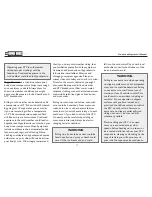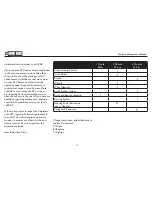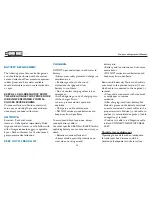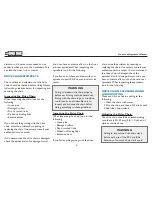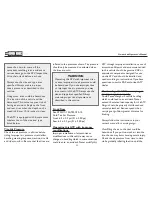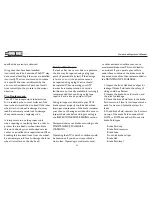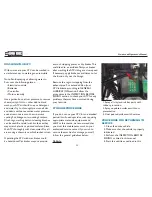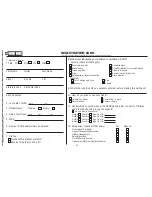
2010
Owner and Operator’s Manual
17
100 % ELECTRIC RANCH-HAND ATV
fall into the cold water. Check with local
authorities to verify the thickness of the
ice and areas to avoid.
WARNING
Failing to use extra care when operating
on slippery surfaces such as hard-packed
snow and ice could be hazardous. Failing
to use extra care could cause loss of
traction or loss of vehicle control. This
could result in an accident, including an
overturn. Do not operate on slippery
surfaces until you have learned and
practiced the skills necessary to control
the ATV on such terrain. Always use
extra care on slippery surfaces. Avoid
riding on snow or ice covered hills
whenever possible.
Practice riding your ATV in an open
snow or ice covered area, at slow
speeds, before heading out on snow- or
ice-covered trails. Learn how your ATV
responds to steering and braking on the
type of terrain you will encounter on
your ride. Your eyes may be sensitive to
that if you do any cold-weather riding, that
you familiarize yourself with the symptoms,
treatment, and prevention of hypothermia.
Information is available at libraries and
through government agencies. Plan your
winter rides with safety and comfort in mind.
Dress for the worst conditions you might
encounter. Be prepared for bad weather
and ATV breakdowns. Wear warm, water-
resistant clothing such as thermal underwear,
snowmobile suits, lined gloves, lined boots,
and wool socks.
Riding on snow-covered terrain, even with
care, could be hazardous. Snow may cover
rocks, holes, ice or other hazards that can
cause loss of control. Severe injury or death
could occur if you lose control of the ATV.
Go slowly and be careful when riding on
snow-covered terrain. Always be alert to
changing terrain conditions.
WARNING
Riding on a frozen lake or river could be
hazardous. Serious injury or death could
occur if the ice breaks and you could
Operating your ATV in cold weather
without proper clothing could be
hazardous. Continued exposure in the
cold weather could lead to Hypothermia.
Hypothermia
is a condition where your
body’s inner temperature drops low enough
to cause injury or death. Always dress for
the worst weather conditions you might
encounter. Be prepared for bad weather and
ATV breakdowns
Riding in cold weather can be hazardous. At
a temperature of 10°F, the wind chill created
by going just 10 mph makes you as cold as
if you were standing still at a temperature
of -9°F. At this temperature, exposed flesh
will freeze in just a few minutes. Continued
exposure in the cold weather could lead to
hypothermia. Hypothermia occurs when your
body’s inner temperature drops. Symptoms
include numbness in the extremities (hands,
feet, arms, and legs), and shivering. Damp
clothing contributes to hypothermia because
cold water on your skin will drain heat from
your body’s core. We strongly recommend















